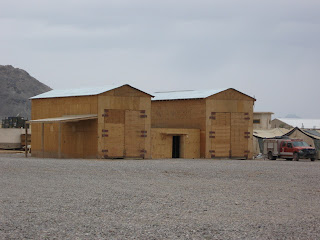Over the course of my military career, I have had several
opportunities to travel to strange lands and live in some less than ideal
environments. Sometimes, we lived in tents, ate cold rations out of a foil
envelope, and utilized “facilities” that would make one yearn for the “Porta Potty”
that bakes in the summer sun. Other times we lived in plywood huts that
provided a little more protection from the elements but was still smack dab in
the middle of hell. Once, I even stayed in a “subdivision” complete with
concrete houses and a cul-de-sac with a basketball goal. Regardless of what the
living conditions started off as, they always got a little better. This was not
because the Army or the Marines suddenly felt sorry for the troops and air
dropped a sofa, but instead was directly due to the fortitude of the Marines,
Soldiers, Sailors and Airmen located there.
See, no matter where one goes, there is an innate need that
tells us we have to make it better. We have to make our surroundings more “homey”.
As such, the Combat Carpenter is born. He or she rises up out of the grains of
sand and scours the area for anything which could be used. Suddenly that stack
of wooden pallets disappears. An old crate once used to package litters moves
to a new home as it transforms into a desk or makeshift entertainment center.
Nails are pulled and straightened out on rocks, as screws back out with the
help of a multi tool. What look like the makings of a good bon fire becomes
bench swings, desks, loft beds and so much more. The combat carpenter finds
things to trade with and acquires a few sheets of plywood which have been in
the desert far too long. Before being used, glue (or similar substance) must be
applied to prevent the layers from peeling apart. Soon lumber and plywood
become more valuable than cash. A box of straight, unused 16 penny nails
becomes the mythical treasure under the rainbow. As down time comes, the sounds
of hand saws and hammers can be heard. Occaisionally, an experienced Combat
Carpenter, with multiple trips under their belt, will produce a cordless circular
saw and drill. Sometimes, these experienced ones produce a box of nails or
screws, a carpenter’s triangle, or even a tape measure.
Other items get repurposed as well. The old, warn out cargo
strap suddenly becomes the webbed weave for a chair or bench. Dispensed casings
find themselves hanging to form wind chimes. Discarded tangles of 550 cord
(paracord) shape an intricate web to build makeshift shelving or even a hanging
seat or hammock. Then there are the decks. Dimensioned lumber comes in from a
long forgotten requisition, submitted by a previous unit, and a deck is born
from which more ideas and comforts of home spawn forth.
By the time the next unit arrives, small sectors of comfort
have taken hold in the form of morale areas / tents. As the new unit settles in
and the old unit leaves, a new generation begins to dream of how they can
improve their surroundings. Once again the sounds of hand saws and hammers fill
the air as saw dust joins the never ending blowing sand.
 | |
| Dispensed aircraft flare casings are cut to various lengths to form a wind chime |
 |
| Contractor built, plywood fire station |
 |
| Deck and benches (car seats too) built at Camp T.Q., Iraq |
The little stuffed animal is "Lil B" my version of a traveling gnome
 |
| Notice the seat is a web of old cargo straps |
 |
| How do you put 4 men in a 2 man room? Build a 4 man bunk |
Have you been deployed before? Do you have pictures anything built by our troops? Send them to me and I’ll post them in future editions of
Combat Carpenter.
No comments:
Post a Comment